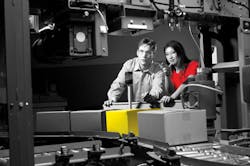How Safety Solutions Support Sustainable Manufacturing
With the severe economic challenges global manufacturers face today, every program and initiative considered gets a second, closer look—one that must pass muster on the balance sheet. In this environment, some are asking whether the recent rise of manufacturing sustainability programs can survive the current crisis for the long term. An analysis proves the answer to be yes, and one of the more interesting aspects of that analysis is how safety, once considered more of a cost than a value, is proving to be an integral part of sustainable manufacturing.
“When it first started out, sustainability was a regulatory-driven issue,” says Bob Ruff, senior vice president, control products and solutions at Rockwell Automation. “But now, infrastructures around the world can’t keep up with the demand that’s put on them.” There are not enough power plants. Water is an issue. When it comes to putting waste back into the stream, there is severely limited space.
“I think this will put sufficient pressure on the business community to keep sustainability as a forefront issue for a long time to come,” Ruff continues. “And the pressures that businesses are under from a profitability standpoint will not lighten up. In this increasingly competitive and difficult environment, sustainable production will help drive the bottom line.”
According to Ruff, one of the strongest pillars supporting sustainable manufacturing is safety. “For a long time, the purpose of safety was to prevent injuries or damage machinery,” he says. “In the past, safety was approached with that narrow but important focus, it didn’t provide a lot of efficiencies. Today it is part of the sustainability process because we’ve developed safe and flexible working processes and embedded those processes into the overall project. Now you’re not just protecting workplace safety, the machinery, or the product itself. Instead, with today’s systems, which have so much power, capability, and flexibility, you’re actually providing a manufacturing environment that’s safe and highly efficient.”
Safety That Is Integral to Manufacturing Sustainability
Sustainability operates at multiple levels in today’s manufacturing organizations. At the highest level, it means reducing dependence on fossil fuels, boosting energy savings, and building competitive advantage. At the functional level, it means reducing emissions and waste, measuring and reporting results, minimizing raw material waste, and improving financial performance. At the safety level, it means protecting workers, products, and customers, and preserving the integrity of the brand.
“For us, safety in the manufacturing workplace has been around since we started,” says Mark Lee, Engineering/ELSP director, commercial products supply, at worldwide beverage leader Coca-Cola. “As part of our sustainability program, we attempt to drive safety through our entire supply chain, distribution network, and bottling partners because we truly believe our business is only as sustainable as the communities where we operate.”
Seven major safety issues face the sustainable manufacturer:
Building safety into the manufacturing process helps address these issues successfully. “When safety is integrated into the manufacturing process, productivity improvements strengthen your competitive advantage and protect the equity of your brand,” notes Ruff.
Safety audits and assessments help provide machine safety and minimize downtime.
Functional safety technology increases process yields, monitors quality, and monitors consistency.
Chain of custody product visibility is improved.
Safety automation systems can be wholly integrated with the standard plant automation system, providing a powerful single platform to perform designed safety functions, meet required standards, and efficiently operate the plant.
“These safety systems accommodate all machine lifecycle tasks, including design, start-up, operation, and maintenance—reducing these costs, time to market, and improving performance,” concludes Ruff.
Safety Not Only Protects, but Pays
Central to the idea of incorporating safety into sustainable manufacturing processes is the belief that corporate investment in social and environmental responsibilities supports business performance and strengthens company image. While it is true that reputation as a corporate asset has played a major historical role in the motivation for safety initiatives, increasingly the economic imperative for safety is taking center stage as a driving factor.
Sustainable manufacturing practices offer one of the best long-term solutions to overcome the rising costs of energy and raw materials, as well as to control other operational expenses, such as worker’s compensation, lost productivity, and product liability. Further, raising the level of safety in the manufacturing process improves employee retention and morale. “Safety is now viewed by industry leaders as a priority on their sustainable agendas,” says Ruff. “You can’t have a sustainable operation if you don’t protect your people and have systems that are designed to enhance productivity and safety.”
Today, safety that is engineered and embedded into systems and processes at the front end provides safe, flexible, and efficient systems that increase productivity while supporting the goals of sustainable manufacturing.
Rockwell Automation Inc.www.rockwellautomation.com800.223.5354
